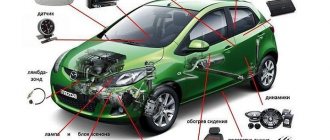The battery voltage and its energy capacity are the main parameters that you first need to pay attention to. You can also find out the degree of charge of the battery by voltage, but for this the car owner must exercise control over the voltage value of the car battery. If you do not forget about performing this procedure, you can increase the service life of the device and save yourself from the negative consequences of its sparseness.
From our article you can find out what the voltage of a car battery is, what value is considered normal, what voltage should be on a charged battery, what the battery voltage is when the engine is running, as well as the procedure for determining the battery charge by voltage using a table.
Charged battery voltage
Power is supplied to a charged car battery using a generator. However, in this case, one circumstance must be taken into account: ensuring the full functioning of the battery using this method is only possible if you drive the car for at least 100 km. Therefore, you must not forget about the importance of this procedure and check the car battery voltage on time.
Charge table
Charge table - summarized data that allows you to determine the total charge of the battery, taking into account the battery model and external factors. If you measure U at the current terminals, you can calculate the overall charge level, thus understanding whether the battery needs to be charged or whether it is working normally. The summary table also shows the electrolyte density and freezing point.
Battery charge table by voltage.
To prevent the driver from having problems starting the engine, it is recommended to regularly monitor the battery parameters using a voltmeter. A charged battery should show a voltage of 12.6-12.9 volts. In this case, it works normally and does not require additional manipulations. If the measuring device shows low values, it is necessary to charge the battery and possibly check the condition of the electrical network. If measurements are carried out in frosty winter conditions, a charge table should be used.
How many volts should a charged battery have?
How many volts should a charged battery show and what voltage should be on the battery for full operation of the device? The voltage of a charged car battery is 12.5V-12.9V, indicating that the battery is 100% ready for use. A device with this value does not need to be connected to the charger, since the electrolyte may boil away, and this can lead to negative consequences. When buying a battery in a store, keep in mind that the voltage of a fully charged car battery should be 12.6V. However, when purchasing a battery, you may encounter a voltage of 12.5V, but there is no need to be upset, since this is the basic condition for a device that has not been used for a long time.
All verification methods
There are different ways to check the voltage of a car battery for its level of discharge. Let's look at them.
Multimeter
To check Akum, Vatra and other brands of batteries installed on KamAZ, Volvo, and BMW vehicles, it is convenient to use a multimeter.
Automotive multimeter
You will find the device in any specialized store; it is available at service stations. For one-time measurements, it’s easier to borrow a multimeter, although most drivers need it regularly.
Digital devices are more expensive than mechanical ones, but they are more convenient to use.
Most likely, the readings of the multimeter and the on-board computer will differ.
Standard dashboard devices often make mistakes and give an insignificant error, since they are not directly connected to the battery. Usually the deviations are on the smaller side.
With the engine running
We have figured out what voltage should be on a charged car battery, now we will consider the procedure for measuring current indicators with the engine running.
The main working tool is a multimeter.
First, take measurements with the engine running - normally the value should be around 13.5–14.0 volts.
If the value is greater than 14.2 volts, the charge is low, the generator will direct energy to charge the battery. Excessive indicators in the winter season are considered the norm in this case.
There is nothing wrong with high current. When everything is in order with the electrical equipment, after 10 minutes the electronic parts of the system will drop the current values to the standard maximum 14 volts.
In the absence of this reaction, the figure is not gradually reset to optimal values, and the battery may be overcharged. It will constantly function at maximum efficiency and the electrolyte will begin to boil away.
When the indicator is less than 13.0–13.4 volts when the engine is turned on, we can talk about the lack of full charge. Do not immediately run to the service center; first, measure the readings with the consumers turned off - this is the air conditioner, radio, headlights, cigarette lighter, etc.
A sharp drop is also possible if the contacts are oxidized - check them before going to the service center and, if necessary, clean them with sandpaper.
Another method of checking is with the power consumption sources turned off and the engine running, you should get 13.6. Check the parameters for compliance, if everything is normal, turn on the low beam, and the indicator should drop by 0.1–0.2 volts.
Now turn on music, split-system, and other energy consumers in the car. Perform the actions gradually, each time you turn on the consumer again, the parameter should drop slightly.
If there are sudden surges, most likely the problem is in the generator system - it is not working at full power, or the brushes are worn out or dirty.
Even if all energy consumers are turned on, the indicator still does not normally fall below 13 V. Otherwise, the battery will begin to discharge heavily and will run out completely.
The solution to the problem in this case is to replace the battery.
With the motor off
You will also need a multimeter to carry out the work. If the reading on the terminals is below 11.8 volts, the car most likely simply will not start; you will have to light it from another car.
The normal level with the engine turned off is 12.5–13.0 volts. A value of 12.9 indicates that the battery is approximately 90% charged, 12.5 - half charged, 12.1 - no more than 10% remaining. These are calculations by eye, but many motorists use them.
An important nuance of checking with the engine turned off is that if the engine has just been turned off, the value will be one, but the morning after it has been idle it will be different.
It is optimal to measure the voltage immediately before the trip. The battery charge level indicates its ability to hold values for several days. If the battery is fully charged and you have not driven for a week or more, the parameter will drop sharply. That is, the value is not constant.
Using a load fork
Testing the battery using a load fork is an accurate, simple and effective way to check the performance of a car battery. Eventually you will find out if the battery is charged.
Connect the plug to the correct battery terminal for a maximum of 5 seconds. At first it should be around 12–13 volts, after the fifth second it should be more than 10 volts, despite the decrease. Such a battery is considered fully charged and can operate under different loads.
When the indicator during testing when checking with a load plug drops to 9 volts, the battery is faulty, and it is recommended to replace it.
During the cold season
A decrease in the temperature of the environment causes changes in the nominal density of the working substance - the electrolyte. Taking into account the battery charge level, the reaction to low temperatures will be determined.
A fully charged battery will have a sharp increase in density, which will cause a sharp jump in measurements.
When the power supply is dead, the density decreases due to frost, and difficulties arise when starting the engine.
Drivers completely mistakenly believe that in winter the battery is further discharged due to low air temperatures. In reality, the role is played not by the low temperature of the environment, but by the slowdown of chemical processes in the battery as a result of frost.
Voltage of a charged car battery without load
What should the car battery voltage be without connecting a load? In most cases, without applying additional load, the voltage is 12.6V. However, in some cases, when charging is complete, the car battery can produce a voltage of up to 13.2V.
There are batteries that have the voltage value written on each battery bank. Here you need to carefully study the following: the electrolytic density in the banks should be the same, however, a slight inaccuracy within 0.02 g/cm3 is possible. The battery voltage in this case is 1.9V. If it drops to a value of less than 1.7V, then the device bank has failed.
Battery charge level table
| Electrolyte density, g/cm³ | Voltage without load | Voltage under load 100 amperes | Battery charge level, % | Electrolyte freezing point, °C |
| 1,11 | 11,7 | 8,4 | 0 | -7 |
| 1,12 | 11,76 | 8,54 | 6 | -8 |
| 1,13 | 11,82 | 8,68 | 12,56 | -9 |
| 1,14 | 11,88 | 8,84 | 19 | -11 |
| 1,15 | 11,94 | 9 | 25 | -13 |
| 1,16 | 12 | 9,14 | 31 | -14 |
| 1,17 | 12,06 | 9,3 | 37,5 | -16 |
| 1,18 | 12,12 | 9,46 | 44 | -18 |
| 1,19 | 12,18 | 9,6 | 50 | -24 |
| 1,2 | 12,24 | 9,74 | 56 | -27 |
| 1,21 | 12,3 | 9,9 | 62,5 | -32 |
| 1,22 | 12,36 | 10,06 | 69 | -37 |
| 1,23 | 12,42 | 10,2 | 75 | -42 |
| 1,24 | 12,48 | 10,34 | 81 | -46 |
| 1,25 | 12,54 | 10,5 | 87,5 | -50 |
| 1,26 | 12,6 | 10,66 | 94 | -55 |
| 1,27 | 12,66 | 10,8 | 100 | -60 |
How many amperes are there in a charged battery?
To answer the question of what voltage the batteries should have, we need to consider the battery data, which is located on the device itself. You need to look at such important characteristics as the voltage of a charged car battery without load and the energy capacity of the device. If the voltage is 65 ampere/hour, then the battery during charging can deliver a current of 5A for 11 hours. To find out the number of amperes, you need to connect the product to the charger.
But you need to take into account that the current ratings of different batteries can vary significantly. It all depends on the additional load. The higher its value, the more energy the battery gives off. Also, the voltage on a charged car battery depends on temperature. So, at temperatures below 0˚C, the battery begins to perform its functions worse, since the rate of chemical passage decreases. reactions.
To achieve normal battery voltage under load, manufacturers began to develop technology for good contact of the solution with the plates, which are made of special materials.
Electrolyte density
The choice of the optimal electrolyte density depends on a number of factors, among which climatic conditions are decisive. For different regions of the country, this indicator is selected taking into account the following setting data:
- in areas with a temperate climate it should be at the level of 1.25-1.27±0.01 g/cm3.
- in regions with cold winters with temperatures down to minus 30 degrees, this indicator is selected based on 0.01 g/cm3 more than the previous value;
- in areas with a hot subtropical climate, its value should be 0.01 g/cm3 less.
Additional information: In regions where severe frosts are common (down to -50 °C), in order to avoid freezing the battery, you will have to increase the density from 1.27 to 1.29 g/cm3.
Data on electrolyte density are given in special tables published in many sources on the Internet.
Density table
A general view of the summary data is given below:
Density indicators are given divided by climatic zones. They also vary depending on the electrolyte condition. The second column indicates the value for the poured (fresh) solution, and the third - after charging the car battery with the selected charging current value.
The required density value during charging and after it is selected with a small margin in the direction of increase. This allows you to take into account an accidental drop in temperature and eliminate the possibility of the battery freezing in winter. In summer, you should do the opposite - choose a lower value. Otherwise, the increased density may lead to boiling of the solution.
| CLIMATE AND SEASON WHEN MEASURING ELECTROLYTE DENSITY | DENSITY (g/cm3) | ||
| Battery charged | Battery discharged | ||
| By 25% | By 50% | ||
| Very cold (temperatures in January range from -50°C to -30°C) | 1,30 | 1,26 | 1,22 |
| Cold (temperature in January from -35оС to -15оС) | 1,28 | 1,24 | 1,20 |
| Moderate (temperature in January from -15°C to -8°C) | 1,28 | 1,24 | 1,20 |
| Warm humid (temperature in January from 0°C to +4°C) | 1,23 | 1,19 | 1,15 |
| Dry hot (temperature in January from -15оС to +4оС) | 1,23 | 1,19 | 1,15 |
In this situation, you should learn to find the “golden mean” between two extremes. On the one hand, high density is fraught with a reduction in battery life. On the other hand, its low indicator leads to a decrease in voltage and difficulty starting the engine. At the same time, we should not forget that when choosing the desired density, the battery capacity must be taken into account.
What voltage on a car battery is generally considered normal?
If the voltage varies from 12.5V to 13.2V, then the parameter is in normal condition.
The last value appears after charging. During a 12-hour break in the operation of the car, the voltage is 12.6V-12.8V. To find out for sure, you need to leave the car alone for 12 hours. Before measurement, you must remove 1 terminal from the battery. In the absence of frost, a new battery with an energy capacity of, for example, 50 A/h can hold a charge for 141 days.
What do you need to remember?
In conclusion, here are some tips that will protect you from mistakes when operating the battery:
- periodically measure the battery voltage and regularly (once every 3 months) recharge it from the mains charger;
- keep the generator, wiring and voltage regulator of the car in good condition for normal battery charging when traveling. The leakage current value must be checked regularly. The leakage current of a car battery, the norm and its measurement are described in the article at the link;
- check the electrolyte density after charging and refer to the table above;
- keep the battery clean. This will reduce the leakage current.
Attention! Never short-circuit the terminals of a car battery. The consequences will be sad.
Under load
To find out the battery voltage, you need to purchase a special device. However, it only allows you to find out the readiness of the battery for further operation and the state of charge of the battery. This product is not suitable for determining energy content. For this reason, there is no way to determine the battery life through this product.
The device has the following equipment, which includes:
- housing with a built-in device, a multimeter;
- spirals that provide resistance;
- cables that have “crocodiles” at the ends for easy connection to the battery;
- switch.
There are 2 types of such products: digital, which show the parameter on the display, and analog, which shows the value using an arrow. The first type is better because it produces a more accurate value compared to the second. Most load forks operate at positive temperatures from 1˚С to 35˚С. But there are products that can work well even at -25˚С, but the cost of such a device will be many times higher than conventional devices. The product can generate current from 100A to 200A.
A battery test using a load fork can be performed within 10 seconds, although according to harmonized standards the test can be performed for 20 seconds.
Measuring Tools
Multimeter
To measure the voltage of a car battery, you will need an ordinary voltmeter, but it is best to use a multimeter - a multifunctional device that measures direct and alternating voltage, resistance and changes in direct current.
A multimeter allows you to check not only voltage, but also current leakage. Such a device can come in handy more than once when working with electrical devices; moreover, it is inexpensive and is sold in any electronics stores.
Before taking measurements, the battery terminals will need to be cleaned of accumulated dust and dirt, and the battery itself will need to be removed from the car. All further manipulations will be carried out either at home or in the garage - wherever is more convenient.
On the multimeter, you need to enable the corresponding mode, setting the value to 20 V. Next, you need to connect the black probe to the negative terminal, and the red probe to the positive terminal. After this, the voltage value will be displayed on the multimeter screen. Nothing critical will happen if the wires are mixed up - no information will simply appear on the display.
Important! Measuring in this way will not provide information about the performance of the battery - for this it is necessary to additionally apply a load.
Engine running
When the car engine is running for more than 10 minutes, the voltage will be from 13.5V to 14.5V. In this case, the parameter will be slightly larger than usual, since the car generator is running. It is necessary to start checking the voltage value after the engine has been running for more than 20 minutes. Then you need to turn on the elements that consume vehicle energy:
- glass cleaners;
- windshield heater;
- stove;
- high beam;
- car radio
After this, the value should change slightly (by about 0.2V). If the value has decreased significantly, then most likely your generator is in a faulty state or there is another situation, for example, if you are using a subwoofer or other powerful device, and the generator cannot cope with such a load, for this reason the voltage begins to sag. In this case, there is only one solution - buy a more powerful generator.
Reasons for discharge
The answer to the question why the battery discharged depends on the nuances of using the vehicle. The key reasons are:
- the battery life has come to an end;
- the generator in the car is faulty and leaks current;
- on-board electrical appliances are used too intensively, the power grid operates with excessive load;
- the driver left the car, forgetting to turn off the radio or side lights before leaving.
The above points should be kept under control. When buying a new battery, you need to check how charged it is. The accuracy of the result is important here, so several measurements are performed, with and without load. This requirement also applies to the situation of buying a used car. It is strongly not recommended to operate the vehicle without checking the charge level.
Normal car battery voltage in winter
Due to winter frosts, the electrolytic density of the battery begins to change. In this case, the voltage will depend on how much charge the battery has. If the percentage is large, then the value will increase, and if the charge is low, then the parameter will decrease, and because of this reason, starting the engine will be problematic.
Car owners have the opinion that in winter this parameter is seriously reduced, but in reality this is not the case; in cold weather, chemical reactions begin to work more slowly.
At a negative ambient temperature of -20˚C, the normal voltage value is 12V. However, due to the slowdown in chemical reactions, changes occur such as:
- Reducing the operating energy capacity of the machine's battery. It is half of the declared parameters that are indicated on the label.
- With an electrolytic density of 1.3 g/cm3, the voltage in winter reaches 12.5V.
- If the external air temperature is less than -25 degrees, then the battery stops recharging from the generator.
To increase the density of the battery in a vehicle used in the northern regions, a concentration of a strong dibasic acid is added to the battery.
When the electrolyte density is in the range from 1.30 g/cm3 to 1.32 g/cm3, the normal battery voltage without additional load at negative temperatures will be 13V.
When increasing this concentration, it is necessary to carefully ensure that the electrolytic density does not reach 1.35 g/cm3, as this may cause breakage of the plates.
What to do if the battery charge is not normal?
The answer to this question is simple. If the battery charge is not normal, the battery needs to be charged. The charging process was described in detail in the article “How to properly charge a car battery with a charger.” Here I would like to note some nuances.
Charger
There are three main types of charging:
- accelerated This mode is often called Boost and can be found on many modern chargers (chargers). In this mode, the battery charge is not fully charged, but it is quite enough to start the engine. This type of charging is used when you need to go urgently and the battery is low. This mode is not recommended to be used continuously. Here, the charge is accelerated by increasing the current strength, which increases the battery life;
- with constant voltage. This type of charging involves maintaining a constant voltage across the terminals. This mode is used in the automatic charge mode on most chargers. It is recommended to use it when the battery is not very discharged (not lower than 12 volts). Read more about car battery voltage in the article at the link. The advantage of this mode is that you don't have to control it. The charger itself will determine when the charge is normal and stop the process;
- with direct current. This charging option involves supplying constant current to the battery. The process is carried out in several stages, in which the current gradually decreases. This mode is recommended when charging a deeply discharged battery. It allows you to charge the battery most fully and evenly. The downside is that you will have to constantly monitor the process, measure the voltage and stop the process when the battery charge is normal.
Battery charging process
In conclusion, I would like to remind you about the safety rules when charging a battery. The process must be carried out in a ventilated area. It is better not to charge in residential areas. There should be no open flames or sparks near the battery being charged. During the charging process, hydrogen is released, which in combination with oxygen forms an explosive mixture!
We also recommend reading the material about how much a car battery weighs.
Charging a battery with constant resistance
Is it possible to charge a battery with a constant resistance? From the formula I =U*R, it is clear that if you set the resistance to a constant value, then the current or voltage will become variable. But inside the battery, resistance is a variable value that affects energy absorption. The total resistance consists of the polarization resistance, which changes, and the ohmic resistance, which remains stable under the same conditions and for a particular battery.
The resistance is affected by temperature, degree of discharge, and electrolyte concentration, which are taken into account in the characteristics of the battery discharge curves. But if in the formula resistance is a variable value over time and the state of the car battery, then current, voltage, or a combination of current and voltage can be constant during charging. To smooth out the charging current, a resistor is used - ballast resistance.











